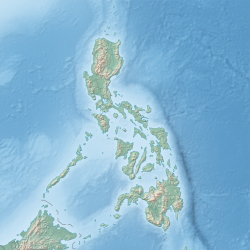Limestone tombs of Kamhantik facts for kids
|
Puntod ng Kamhantik
|
|
 |
|
| Location | Mulanay, Quezon province |
|---|---|
| Coordinates | 13°31′13″N 122°25′13″E / 13.52028°N 122.42028°E |
| Type | Tomb complex / Burial site |
| Part of | Philippines |
| Area | 280 hectares |
| History | |
| Material | Limestone |
| Founded | c. 9th century |
| Abandoned | c. 15th century |
| Cultures | Ancient Tagalog people |
| Associated with | Maharlikas and common peoples |
| Site notes | |
| Excavation dates | 2011–2012 |
| Management | Buenavista Protected Landscape of Mulanay, Quezon, National Museum of the Philippines |
The Limestone Tombs of Kamhantik are ancient burial sites found in the jungles of Mulanay, Quezon province, in the Philippines. These tombs are over a thousand years old. They are believed to have been built by the early Tagalog people who lived in the area long before the Spanish arrived.
The site has fifteen limestone coffins. Experts believe they were used between the 10th and 14th centuries. However, tests on human bones found there show the site might be even older, from around 890 to 1030 AD. This makes Kamhantik a very special place, as it's the first time such carved limestone tombs have been found in the Philippines.
Contents
Discovering the Ancient Tombs
The area where the tombs are located is a large forest. In 1998, this 280-hectare (692-acre) forest was made a protected area by the government. This was done to keep it safe from people looking for treasure or clearing land by burning trees.
When Were the Tombs Found?
Years ago, treasure hunters found some of the limestone tombs. But it wasn't until 2011 that archaeologists from Manila began to dig up the graves. They soon realized how important these findings were. Many small pieces with unusual writings were found around the site.
What Was Missing?
Experts believe the tombs once had lids. These lids were probably decorated with beautiful designs from ancient times. Sadly, before scientists could fully study the site, many things were taken. The lids, skeletons, and other valuable items that were supposed to be inside the tombs were gone.
Local people said that foreigners with light skin had visited the mountains years before. The National Museum of the Philippines believes that these valuable Filipino treasures might now be in private collections or museums around the world.
Protecting the Site
The Kamhantik site is a key part of the Buenavista Protected Landscape. Locals are working to have this area added to the UNESCO World Heritage List. This list includes places around the world that are very important to human history and culture.
Myths and Local Beliefs
The people of Mulanay have many stories about the Kamhantik tombs. They believe their Tagalog ancestors built the tombs with help from magical beings called anitos. These anitos were sent by Bathala, who is the supreme god in Tagalog beliefs.
A Sacred Place
Even before scientists found the ruins, the people of Mulanay knew about them. They consider the ruins one of the most sacred places for the anitos. Because of this, they see the site as a dambana, which is a holy shrine.
For a long time, the local people did not go into the area much. They believed it was too sacred and that they might disturb the anitos living there. This is why the area was explored by others without the knowledge of the townsfolk. It was only in 2011 that people realized the site had been disturbed and many items had been taken. All the seals on the tombs were gone, along with sacred objects and most of the bone fragments inside.
See also
 In Spanish: Tumbas caliza de Kamhantik para niños
In Spanish: Tumbas caliza de Kamhantik para niños


